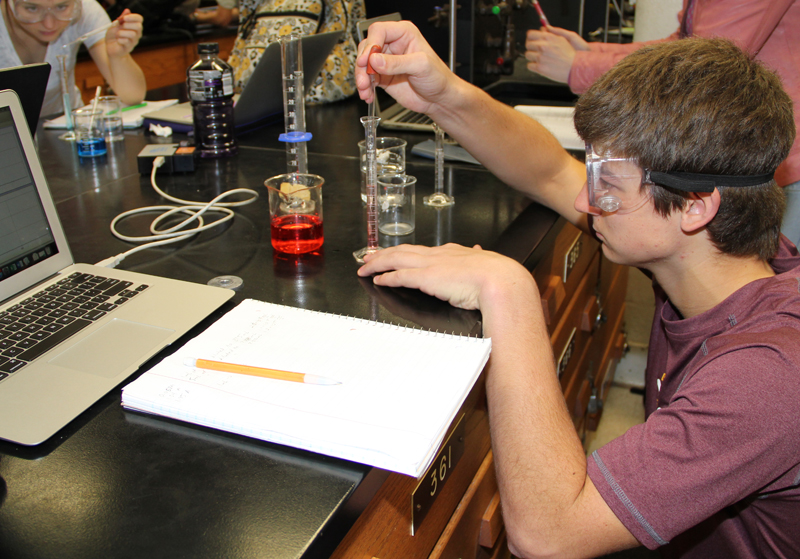

Main navigation | Main content

Christopher Greve, who is enrolled in the general chemistry laboratory, uses UV/Vis spectroscopy to identify artificial colors present in a consumer beverage, and then recreates the color profile using food dyes provided in the laboratory. Pictured on the front page is Joshua Wiczek taking the hybrid, flipped general chemistry course.
The times they are a changing, and when it comes to teaching undergraduate students, the Department of Chemistry is leading the way with innovative teaching methods in its classrooms and laboratories.
Online courses, hybrid or flipped classrooms that combine online learning with in-class focused, interactive learning activities, and problem-based and guided-inquiry laboratories are part of the re-imagined teaching repertoire in the Department of Chemistry. The department is at the forefront of the latest modern and innovative teaching pedagogy for its large-enrollment general chemistry and organic chemistry courses. It is also a pioneer with its uniquely designed analytical curriculum and laboratory and its advanced chemical biology laboratory.
Leading this innovation are professors David Blank, director of Undergraduate Studies, Michelle Driessen, general chemistry director, Nicholas Frost, analytical laboratory director, and Jane Wissinger, organic chemistry director. Professor Erin Carlson created the department’s advanced chemical biology laboratory—a first of its kind for the Department of Chemistry (see story on unique laboratory curriculums).
In general and organic chemistry, the department is one of a few, large-enrollment chemistry programs nationwide that uses problem-based and guided-inquiry approaches in its laboratories. These approaches are designed to help students develop their critical-thinking and problem-solving skills, to teach them how to work effectively in teams, and to encourage them to become comfortable with adapting-on-the-fly in the lab.
“We are making changes in our teaching pedagogy so our students are prepared for research in industry and academia, and teaching. We are hearing from industry leaders that they expect students to work collaboratively in teams, be critical thinkers, and be innovative problem-solvers,” said Blank.
Driessen has worked hard to move her general chemistry laboratories away from the traditional laboratory model of “cookbook” or “recipe” experimentation. No longer are students given carefully prescribed experimental procedures to follow step-by-step. Instead, they are presented with one-paragraph problems and asked to design and carry out experiments to solve those chemical questions. Working in teams, the students delve into practical aspects of the experiment such as: What questions are they trying to answer? What observations might provide answers? What experiments might help? If the experiments don’t work, what might they do next?
In a typical lab, students perform experiments and trouble-shoot any problems they encounter, give oral reports and discuss what they learned, summarize their progress, and plan for their next lab session. Teaching assistants coach the student teams through the problem-solving process.
Goals for students include experience in experimental design, and thorough, practical knowledge of basic laboratory skills. Project-based labs also engage students in teamwork, foster creativity in science, and emphasize strong written and oral communication. Grading is based on group and individual work, plans, summaries and presentations, lab notebook pages, peer reviews, and formal reports. These laboratory courses are also completely digital, with the lab manual embedded into electronic laboratory notebooks.
“Students learn basic lab skills while practicing and discussing real science,” said Driessen.
In Wissinger’s organic laboratories, a guided-inquiry approach means that every experiment begins with a question that needs to be addressed. Teaching assistants lead the students in pre- and post-laboratory student-driven discussions that are designed to engage the students and build critical-thinking skills.
The department’s organic chemistry guided-inquiry laboratories are also focused on green chemistry. Wissinger is a national leader in creating and implementing green chemistry experiments, which exemplify modern strategies used by academia and industry to develop chemical syntheses and processes that are “benign by design” and address issues of sustainability. Students are trained in the principles of green chemistry and explore topics such as the use of renewable materials, solvent-less reactions, and catalysts. The green emphasis also has also cut in half the amount of chemical waste produced in the labs.
For Wissinger this is an exciting time for students to be interested in chemistry where “there is both challenge and opportunity to solve society’s most pressing environmental and sustainability problems through green chemistry innovations.” Additionally, she hopes that “all of the students enrolled in this course carry with them a heightened awareness of the relevance of chemistry in their lives.”
Driessen developed an online introductory chemistry course about six years ago. She has now used that expertise to develop two hybrid general chemistry courses. Her hybrid model, in some ways a flipped classroom model, is unique due to the reduced seat time for students and what those students do during class time. Rather than meeting for 150 minutes in class each week, the students see Driessen for one 75-minute problem-solving session.
Outside of class, students watch videos and take notes, work on sample problems, do online homework problems, and take advantage of Driessen’s office hours. Students meet once a week for face-to-face problem-solving activities. Working in groups of nine at their tables, students spend class time focusing on those activities, respond to selected questions with electronic clickers or color cards, sketch their work on white boards, and view chemical demonstrations. Driessen checks in with the class several times to make sure groups are working through the activities and understanding the concepts.
This is not the department’s first flipped classroom. Based on his experience teaching a Massive Open Online Course, Professor Christopher Cramer developed a flipped classroom for the department’s computational chemistry course.
These modern models of teaching in classrooms and laboratories require different spaces. Active-learning pedagogies work best using round tables, laptop connections, and projection equipment. That kind of space is available in Bruininks Hall.
Modern laboratories not only need space for experiments, but also spaces where students can discuss their experiments, collaborate in groups, and give presentations. Those spaces currently don’t exist in the Kolthoff Hall and Smith Hall laboratories, thus, driving the current effort to build a new teaching laboratory building.